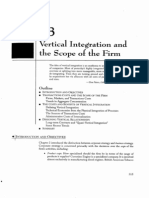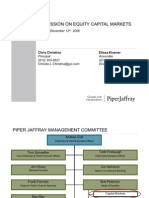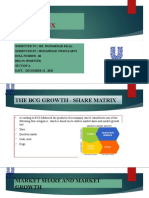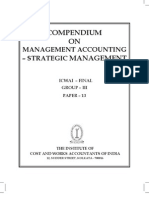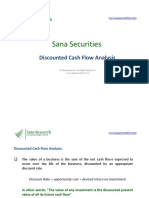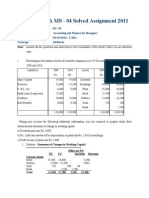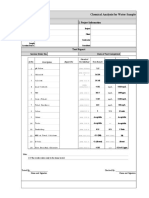CH - 19 (The BCG Matrix)
CH - 19 (The BCG Matrix)
Uploaded by
suryaCopyright:
Available Formats
CH - 19 (The BCG Matrix)
CH - 19 (The BCG Matrix)
Uploaded by
suryaOriginal Title
Copyright
Available Formats
Share this document
Did you find this document useful?
Is this content inappropriate?
Copyright:
Available Formats
CH - 19 (The BCG Matrix)
CH - 19 (The BCG Matrix)
Uploaded by
suryaCopyright:
Available Formats
Part- III : Strategy Formulation and Choice
Ch-19: The BCG Matrix
Chapter
19 The BCG Matrix
Copyright © 2008, C Appa Rao, B Parathiswara Rao, K Sivaramakrishna
19– 1 C Appa Rao, B Parathiswara
Strategic Management and Business Policy Text and Cases Rao, K Sivaramakrishna
Excel Books
Part- III : Strategy Formulation and Choice
Ch-19: The BCG Matrix
Introduction
The BCG matrix was developed by the Boston Consultancy group in 1970s.
It is also called the “Growth share matrix”. This is the most popular and the
simplest matrix to describe a corporation’s portfolio of businesses or
products.
BCG matrix is based on the premise that majority of the companies carry
out multiple business activities in a number of different product-market
segments. Together, these different businesses form the business portfolio
of the company, which need to be balanced for overall profitability of the
company.
To ensure long-term success, a company’s business portfolio should consist
of both high-growth products in need of cash inputs and low-growth
products that generate excess cash.
Copyright © 2008, C Appa Rao, B Parathiswara Rao, K Sivaramakrishna
19– 2 C Appa Rao, B Parathiswara
Strategic Management and Business Policy Text and Cases Rao, K Sivaramakrishna
Excel Books
Part- III : Strategy Formulation and Choice
Ch-19: The BCG Matrix
The BCG Matrix
The BCG matrix helps to determine priorities in a product portfolio. Its basic
purpose is to invest where there is growth from which the firm can benefit, and
divest those businesses that have low market share and low growth prospects.
Each of the products or business units is plotted on a two-dimensional matrix
consisting of:
The BCG Matrix
a) Relative market share
b) Market growth rate. Question
Stars
High market Marks
growth rate
Low market Cash Cows
Dogs
growth rate
High relative Low relative
market share market share
Copyright © 2008, C Appa Rao, B Parathiswara Rao, K Sivaramakrishna
19– 3 C Appa Rao, B Parathiswara
Strategic Management and Business Policy Text and Cases Rao, K Sivaramakrishna
Excel Books
Part- III : Strategy Formulation and Choice
Ch-19: The BCG Matrix
Building The BCG Matrix
The stepwise procedure for building the BCG matrix is given below.
1. The various activities of the company are classified into different business
units or SBUs
2. The growth rate of the market is determined and plotted on the Y-axis.
3. The assets employed by the company in each of the business units are
compiled to determine the relative size of the business unit in relation to the
company.
4. The relative market share for different business units is estimated and
plotted on the X-axis
5. The position of each business unit or product is plotted on a matrix of
market growth rate and relative market share. The size of the business is
represented by a circle with a diameter corresponding to the assets invested
in the business. The radius of the circle is given by
r = p .R2
where R represents total sales, P represents sales of the business unit as a
percentage of the total sales of the company.
Copyright © 2008, C Appa Rao, B Parathiswara Rao, K Sivaramakrishna
19– 4 C Appa Rao, B Parathiswara
Strategic Management and Business Policy Text and Cases Rao, K Sivaramakrishna
Excel Books
Part- III : Strategy Formulation and Choice
Ch-19: The BCG Matrix
Analysis Of BCG Matrix
The BCG matrix reflects the contribution of the products or business units to its
cash flow. Based on this analysis, the products or business units are classified
as:
Stars (high growth, high market share)
Cash cows (low growth, high market share)
Question Marks (High Growth, Low Market Share)
Dogs (Low Growth, Low Market Share)
Copyright © 2008, C Appa Rao, B Parathiswara Rao, K Sivaramakrishna
19– 5 C Appa Rao, B Parathiswara
Strategic Management and Business Policy Text and Cases Rao, K Sivaramakrishna
Excel Books
Part- III : Strategy Formulation and Choice
Ch-19: The BCG Matrix
Strategic Implications
The BCG growth-share matrix links the industry growth characteristic with
the company's market share (i.e competitive strength), and develops a
visual display of the company's market involvement, thereby indirectly
indicating current resource deployment.
In terms of BCG classification, the cash position of various types of
businesses can be visualized as shown exhibit .
Cash Position of Various Businesses
S.No. Business Type Cash Source Cash Use Net Cash Balance
1 Cow More Less Funds available, so milk and deploy
2 Star More More Build competitive position and grow
3 Dog Less Less Divest or redeploy proceeds
4 Question Mark Less More Funds needed to invest selectively
to improve competitive position
Copyright © 2008, C Appa Rao, B Parathiswara Rao, K Sivaramakrishna
19– 6 C Appa Rao, B Parathiswara
Strategic Management and Business Policy Text and Cases Rao, K Sivaramakrishna
Excel Books
Part- III : Strategy Formulation and Choice
Ch-19: The BCG Matrix
Critical Assessment Of BCG Matrix
BCG matrix is a very well-known portfolio concept with many advantages
or merits:
1. It is easy to use
2. It is quantifiable
3. It draws attention to the cash flows
4. It draws attention to the investment needs
The BCG Matrix, however, has some serious limitations:
1. It is too simplistic.
2. Link between market share and profitability is not strong.
3. Growth rate is only one aspect of industry attractiveness.
4. It is not always clear how markets should be defined.
5. Market share is considered as the only aspect of overall competitive
position.
6. Many products or business units fall right in the middle of the matrix, and
cannot easily be classified. Copyright © 2008, C Appa Rao, B Parathiswara Rao, K Sivaramakrishna
19– 7 C Appa Rao, B Parathiswara
Strategic Management and Business Policy Text and Cases Rao, K Sivaramakrishna
Excel Books
Part- III : Strategy Formulation and Choice
Ch-19: The BCG Matrix
BCG Modifications
It was in 1981 that the Boston Consulting Group realized the limitations of
equating ‘market share’ with the ‘competitive strength’ of the company. They
have admitted that the calculation of market share is strongly influenced by
the way the total market domain is defined.
The Boston Consulting Group came up with a modified version of the BCG
matrix.
The New BCG Matrix
According to the New BCG matrix, the businesses are classified as
follows:
Fragmented businesses are small, confined to a region.
Specialized businesses are focused segment and are characterized by
steep learning curves.
Volume businesses are those where economies of scale and increasing
returns operate. Stalemated businesses are those where it is difficult to gain
advantage. Copyright © 2008, C Appa Rao, B Parathiswara Rao, K Sivaramakrishna
19– 8 C Appa Rao, B Parathiswara
Strategic Management and Business Policy Text and Cases Rao, K Sivaramakrishna
Excel Books
You might also like
- A Year To Be Content WithDocument40 pagesA Year To Be Content WithAnonymous Feglbx5No ratings yet
- Grand Strategy Matrix & QSPM MatrixDocument12 pagesGrand Strategy Matrix & QSPM Matrixnarmeen khalidNo ratings yet
- 7ps of Toyota Marketing MixDocument2 pages7ps of Toyota Marketing MixRuel VillanuevaNo ratings yet
- Suria ReportDocument37 pagesSuria Reportccohen6410No ratings yet
- Betaworks Shareholder Letter 2012Document32 pagesBetaworks Shareholder Letter 2012Erin GriffithNo ratings yet
- PE Ecosystem - PAI PartnersDocument4 pagesPE Ecosystem - PAI PartnersLeopold TikvicNo ratings yet
- Evercore Graduate BrochureDocument14 pagesEvercore Graduate Brochureheedi0No ratings yet
- Credit Suisse IBD Case CompetitionDocument4 pagesCredit Suisse IBD Case CompetitionSahit Chowdary GarapatiNo ratings yet
- Product Market StakeholdersDocument3 pagesProduct Market Stakeholdersqaqapataqa100% (1)
- Tata Motors Balance Sheet, Tata Motors Financial Statement & AccountsDocument4 pagesTata Motors Balance Sheet, Tata Motors Financial Statement & AccountssuryaNo ratings yet
- Archaeology Book Collection 2016 PDFDocument30 pagesArchaeology Book Collection 2016 PDFAung Htun LinnNo ratings yet
- Investment Memo - RoomyDocument29 pagesInvestment Memo - Roomyhishamsyed85No ratings yet
- PWC AC Kolkata Tax Associate JDDocument4 pagesPWC AC Kolkata Tax Associate JDAngalakurthy Vamsi KrishnaNo ratings yet
- Analysys Mason Due Diligence ExpertiseDocument9 pagesAnalysys Mason Due Diligence ExpertiseJessievanNo ratings yet
- Case Study #3 PDFDocument7 pagesCase Study #3 PDFRoy John SarmientoNo ratings yet
- Brigade Metropolis Investment MemoDocument20 pagesBrigade Metropolis Investment Memoicasanova23No ratings yet
- InvestAsian Investment Deck NewDocument14 pagesInvestAsian Investment Deck NewReidKirchenbauerNo ratings yet
- Questions Financial Statements Financial AnalysisDocument3 pagesQuestions Financial Statements Financial AnalysisBir kişiNo ratings yet
- AIBC B.C.J. PartnersDocument11 pagesAIBC B.C.J. PartnersHY CatherineNo ratings yet
- Vertical Integration and The Scope of The Firm - Cap 13Document15 pagesVertical Integration and The Scope of The Firm - Cap 13Elena DobreNo ratings yet
- Chris Christina Elissa KlueverDocument22 pagesChris Christina Elissa Kluevervisa_kpNo ratings yet
- Three (3) Major Decisions The Finance Manager Would TakeDocument11 pagesThree (3) Major Decisions The Finance Manager Would TakeJohn Verlie EMpsNo ratings yet
- Chapter 7 Intro To Risk and Return - UpdatedDocument64 pagesChapter 7 Intro To Risk and Return - UpdatedJec AlmarzaNo ratings yet
- Chapter 4Document24 pagesChapter 4FăÍż SăįYąðNo ratings yet
- Unilever BCG MatrixDocument8 pagesUnilever BCG MatrixAwaisNo ratings yet
- Xerox To Split Into Two CompaniesDocument46 pagesXerox To Split Into Two CompaniesUSA TODAYNo ratings yet
- C 13Document416 pagesC 13Arun Victor Paulraj50% (2)
- Indian Rural Market: Challenges and Ways Ahead: Sudesh Kumar Dr. Bimal Anjum Dr. Suman NayyarDocument5 pagesIndian Rural Market: Challenges and Ways Ahead: Sudesh Kumar Dr. Bimal Anjum Dr. Suman NayyarVidhiNo ratings yet
- Starboard Darden Sept 2014 294 Slide Deck PPT PDF PresentationDocument294 pagesStarboard Darden Sept 2014 294 Slide Deck PPT PDF PresentationAla BasterNo ratings yet
- Market Value AddedDocument13 pagesMarket Value Addedapi-3820619100% (2)
- Barings CaseDocument3 pagesBarings CaseAnonymous LC5kFdtcNo ratings yet
- CASE STUDY 1 (Strategic Marketing Management) Mirela FashionsDocument1 pageCASE STUDY 1 (Strategic Marketing Management) Mirela FashionsKhyber MassoudyNo ratings yet
- Investment Banking TrendsDocument30 pagesInvestment Banking TrendsjezlinjacobNo ratings yet
- CAPITAL BUDGETING in Automobile SectorDocument12 pagesCAPITAL BUDGETING in Automobile SectorSheel VictoriaNo ratings yet
- 2012 JulyDocument8 pages2012 Julyjen8948No ratings yet
- JD For Deloitte Advisory Usi - Valuation (Tangible Assets)Document3 pagesJD For Deloitte Advisory Usi - Valuation (Tangible Assets)vedangNo ratings yet
- Investor Relations Update: February 2020Document27 pagesInvestor Relations Update: February 2020chandraNo ratings yet
- IDFC First Bank Investor Presentation FY20 UpdatedDocument58 pagesIDFC First Bank Investor Presentation FY20 UpdatedSaksham SinhaNo ratings yet
- ODD & CDD Slides For ProposalDocument3 pagesODD & CDD Slides For ProposalAdeel ShaikhNo ratings yet
- 13corporate Social Responsibility in International BusinessDocument23 pages13corporate Social Responsibility in International BusinessShruti SharmaNo ratings yet
- Luxury Brand M&A CaseDocument16 pagesLuxury Brand M&A CaseAditisawhney collegeNo ratings yet
- Restructuring Term SheetDocument3 pagesRestructuring Term SheetFrancisco GarcíaNo ratings yet
- Aviva UK: Goldman Sachs Conference, June 2008Document25 pagesAviva UK: Goldman Sachs Conference, June 2008Aviva GroupNo ratings yet
- Ali Strama PDF FreeDocument155 pagesAli Strama PDF FreeMichelle AquinoNo ratings yet
- GE Capital Overview Due DiligenceDocument5 pagesGE Capital Overview Due DiligenceLaila ChahidNo ratings yet
- Business Valuation ReportDocument21 pagesBusiness Valuation ReportKyaw Htin WinNo ratings yet
- Co-Branding:: Bayerische Motoren Werke AG BMWDocument3 pagesCo-Branding:: Bayerische Motoren Werke AG BMWdaniyalNo ratings yet
- Course Syllabus - Strama 1st Sem Ay 2017-2018Document10 pagesCourse Syllabus - Strama 1st Sem Ay 2017-2018api-1942418250% (1)
- Risk Management NotesDocument18 pagesRisk Management Noteswww.pubg4.co.inNo ratings yet
- DCF Analysis PDFDocument11 pagesDCF Analysis PDFanandbajaj0No ratings yet
- Inv AppDocument83 pagesInv AppMueen KhanNo ratings yet
- 7401D001 Direct TaxesDocument22 pages7401D001 Direct TaxesMadhuram SharmaNo ratings yet
- Strategic Management - MGMT 689Document20 pagesStrategic Management - MGMT 689Mohammed ZamanNo ratings yet
- Describe Procedures For Assessing and Measuring The Risk of A Single Asset 1Document12 pagesDescribe Procedures For Assessing and Measuring The Risk of A Single Asset 1Abdullah ghauriNo ratings yet
- Nestle Report AnalysisDocument3 pagesNestle Report AnalysisAkshatAgarwalNo ratings yet
- IGNOU MBA MS - 04 Solved Assignment 2011Document12 pagesIGNOU MBA MS - 04 Solved Assignment 2011Nazif LcNo ratings yet
- File MB0045-Financial Management SolvedDocument24 pagesFile MB0045-Financial Management Solvedmanishdubey 2001No ratings yet
- Value Chain Management Capability A Complete Guide - 2020 EditionFrom EverandValue Chain Management Capability A Complete Guide - 2020 EditionNo ratings yet
- BCG MatrixDocument2 pagesBCG MatrixAlex TranNo ratings yet
- BCG Matrix: Sayali Ware 111 Yogita Zope 119 Niraj Trivedi 103 Shashank Shah 106 Dheraj Kanchan 77 Rahul Srivastav 99Document29 pagesBCG Matrix: Sayali Ware 111 Yogita Zope 119 Niraj Trivedi 103 Shashank Shah 106 Dheraj Kanchan 77 Rahul Srivastav 99inaya khanNo ratings yet
- DeclarationDocument1 pageDeclarationsuryaNo ratings yet
- Organic vs. InorganicDocument1 pageOrganic vs. InorganicsuryaNo ratings yet
- Social Audit: Strategic Management andDocument10 pagesSocial Audit: Strategic Management andsuryaNo ratings yet
- 7s Model-BCG ModelDocument17 pages7s Model-BCG Modelsurya100% (1)
- Cost Control and ReductionDocument14 pagesCost Control and ReductionsuryaNo ratings yet
- Babu Banarasi Das: National Institute of Technology and ManagementDocument1 pageBabu Banarasi Das: National Institute of Technology and ManagementsuryaNo ratings yet
- Batch Operating System: Multitasking Operating Systems Are Also Known As Time-Sharing SystemsDocument2 pagesBatch Operating System: Multitasking Operating Systems Are Also Known As Time-Sharing SystemssuryaNo ratings yet
- Index: S.No Name of The Program Date RemarksDocument3 pagesIndex: S.No Name of The Program Date RemarkssuryaNo ratings yet
- Business PolicyDocument11 pagesBusiness PolicysuryaNo ratings yet
- Msme Amendment in Section 43B - A Huge Impact On Tax LiabilityDocument3 pagesMsme Amendment in Section 43B - A Huge Impact On Tax LiabilityVikash AgarwalNo ratings yet
- PowerLogic ION 6200 3000BR606R1009Document4 pagesPowerLogic ION 6200 3000BR606R1009Souca Paul IoanNo ratings yet
- Aspb 2012 - 106Document204 pagesAspb 2012 - 106arunprabhu_dhanapalNo ratings yet
- An Integrated Anaerobic-Aerobic Bioreactor (IAAB) For The Treatment of Palm Oil Mill Ef Uent (POME) : Start-Up and Steady State PerformanceDocument11 pagesAn Integrated Anaerobic-Aerobic Bioreactor (IAAB) For The Treatment of Palm Oil Mill Ef Uent (POME) : Start-Up and Steady State Performancenavri_nalhadNo ratings yet
- Project Information 1. Sample Identification: Chemical Analysis For Water SampleDocument1 pageProject Information 1. Sample Identification: Chemical Analysis For Water SamplecivillabNo ratings yet
- How To Write Security Test CasesDocument4 pagesHow To Write Security Test CasesRohit KhuranaNo ratings yet
- SZI - Archieve PortalDocument1 pageSZI - Archieve Portalwisdom malongweNo ratings yet
- Project OdDocument12 pagesProject Od8662No ratings yet
- Lesson PlanDocument3 pagesLesson PlanChristian Dave BalasaNo ratings yet
- 5500 - Service ManualDocument277 pages5500 - Service ManualVictor LinaresNo ratings yet
- Storage Devices & Media: ObjectivesDocument11 pagesStorage Devices & Media: ObjectivesShahith SNo ratings yet
- European Journal of OrthodonticsDocument288 pagesEuropean Journal of Orthodonticsikeuchi_ogawaNo ratings yet
- Spray DryingDocument3 pagesSpray DryingDeepak ChachraNo ratings yet
- University of Cambridge International Examinations International General Certificate of Secondary EducationDocument24 pagesUniversity of Cambridge International Examinations International General Certificate of Secondary EducationMohamed AnsaryNo ratings yet
- Process RecordingDocument12 pagesProcess Recordingapi-302732994100% (4)
- Maintenance ManualDocument216 pagesMaintenance Manualtayyab zafarNo ratings yet
- MAEG3050Document5 pagesMAEG3050LeungSiuYapNo ratings yet
- Dynamic ARC Flash Analysis SiemensDocument8 pagesDynamic ARC Flash Analysis SiemensarunmozhiNo ratings yet
- CMC VRTX - Start HereDocument208 pagesCMC VRTX - Start HereilirisaiNo ratings yet
- Creating Exceptional Portraits: An Eye For Birds: A Photographic JourneyDocument5 pagesCreating Exceptional Portraits: An Eye For Birds: A Photographic JourneyAnízio Luiz Freitas de MesquitaNo ratings yet
- Google Cloud Platform Big Data and Machine Learning FundamentalsDocument1 pageGoogle Cloud Platform Big Data and Machine Learning FundamentalsHari PrakashNo ratings yet
- Clustered Cues Clustered Data Nursing Diagnosis PriorityDocument4 pagesClustered Cues Clustered Data Nursing Diagnosis PriorityLoyd TuvillaNo ratings yet
- African Standard Dars 951: African Traditional Medicine - Good Manufacturing Practices (GMP) For Herbal MedicinesDocument35 pagesAfrican Standard Dars 951: African Traditional Medicine - Good Manufacturing Practices (GMP) For Herbal MedicinesAliNo ratings yet
- Photosynthesis in Higher PlantsDocument20 pagesPhotosynthesis in Higher PlantsWilson Quispe LopezNo ratings yet
- Mostafa 2007Document7 pagesMostafa 2007dwiyerlisrNo ratings yet
- Guidance and Counseling - REFLECTION PAPERDocument2 pagesGuidance and Counseling - REFLECTION PAPERMariaNo ratings yet
- The Perfect PresentDocument24 pagesThe Perfect Presenttutorial 001No ratings yet
- Crusher OverViewDocument26 pagesCrusher OverViewAhmad Y. AbughaushNo ratings yet
- Artificial OrgansDocument26 pagesArtificial OrgansEdwin Kimori100% (1)



















